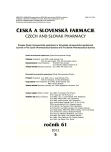Methods of pharmaceutical technology in preparation of pellets for detection of acetylcholinesterase inhibitors
Authors:
David Vetchý; Hana Leštinová; Ivana Tušarová
Authors‘ workplace:
Ústav technologie léků, Farmaceutická fakulta, Veterinární a farmaceutická univerzita, Brno
Published in:
Čes. slov. Farm., 2012; 61, 234-239
Category:
Original Articles
Došlo 4. září 2012 / Přijato 18. září 2012
Overview
A variety of methods and technical equipment are currently available for checking of air contaminants. Generally, all known and sophisticated methods are based on sampling of substances in the air using different collectors or their capture in a suitable medium. However, new detection methods particularly useful in outdoor conditions are still looking for. Detection systems must be transportable, fast acting, inexpensive, sensitive and selective, and their operation should not be complicated. Such an appropriate system for the detection of carbamates and highly toxic organophosphates is detection tubes with microcrystalline cellulose pellets containing immobilized acetylcholinesterase, by which analyzed air is sucked through. The detection is based on the colorimetric Ellman reaction. Experimental work deals with the use of pharmaceutical technology methods for preparation of new variants of pellets for the detection of acetylcholinesterase inhibitors with 20% and 50% content of inorganic fillers (aluminium oxide, kaolin, colloidal silica, nalsit) produced by extrusion / spheronization. Pellets were impregnated by acetylcholinesterase after evaluating quality parameters and were tested for their activity and inhibition with Ellman’s reagent. Pellets without inorganic fillers, containing 50% of aluminium oxide and containing 20% of colloidal silica were evaluated as a suitable filling of detection tubes.
Keywords:
pellets • extrusion/spheronization • inorganic fillers • acetylcholinesterase inhibitors • detection tubes
Sources
1. Pitschmann V., Halámek E., Kobliha Z., Tušarová I. Výzkum detekčních trubiček pro bojové chemické látky v České republice. Chem. Listy 2011; 105, 334–345.
2. Pitschmann V. Analýza toxických látek detekčními trubičkami. 2. vyd. Drahelčice: Econt Consulting 2005; 194 s.
3. Halámek E., Kobliha Z., Pitschmann V. Analýza bojových chemických látek. 1. vyd. Vyškov: Univerzita obrany Brno, Ústav ochrany proti zbraním hromadného ničení 2007; 155 s.
4. Žďárová-Karasová J., Kuča K., Jun D., Bajgar J. Užití Ellmanovy metody pro stanovení aktivit cholinesteras při in vivo hodnocení účinků reaktivátorů. Chem. Listy 2010; 104, 46–50.
5. Hasznos L., Langer I., Gyamathy M. Some factors influencing pellet characteristics made by an extrusion/spheronisation process Part I.: Effects on size characteristics and moisture content decrease of pellets. Drug Dev. Ind. Pharm. 1992; 18, 409–412.
6. Kolektiv autorů: Český lékopis 2009, Praha: Grada Publishing 2009.
7. Sienkiewicz G., Pereira R., Rudnic E. M. Spheronization of theophylline-avicel combinations using a fluidized-bed rotogranulation technique. Drug Dev. Ind. Pharm. 1997; 23, 173–177.
8. Krejčová K., Rabišková M., Vetchý D., Polášek E., Tomášek V., Prokopová A. The influence of drug solubility and particle size on the pellet formulation in a rotoprocessor. Drug Dev. Ind. Pharm. 2006; 32, 585–593.
9. Thommes M., Kleinebudde P. Use of kappa-carrageenan as alternative pelletisation aid to microcrystalline cellulose in extrusion/ spheronisation. I. Influence of type and fraction of filler. Eur. J. Pharm. Biopharm. 2006; 63, 59–67.
10. Ghanam D., Hassan I., Kleinebudde P. Compression behaviour of kappa-carrageenan pellets. Int. J. Pharm. 2010; 390, 117–127.
11. Deasy P. B., Law M. F. L. Use of extrusion-spheronization to develop an improved oral dosage form of indometacin. Int. J. Pharm. 1997; 148, 201–209.
12. Law M. F. L., Deasy P. B. Use of hydrophilic polymers with microcrystalline cellulose to improve extrusion-spheronization. Eur. J. Pharm. Biopharm. 1998; 45, 57–65.
13. Sousa J. J., Sousa A., Podczeck F., Newton J. M. Factors influencing the physical characteristics of pellets obtained by extrusion-spheronization. Int. J. Pharm. 2002; 232, 91–106.
14. Costa F. O., Pais A. A. C. C., Sousa J. J. S. Analysis of formulation effects in the dissolution of ibuprofen pellets. Int. J. Pharm. 2004; 270, 9–19.
15. Vertommen J., Kinget R. The influence of five selected processing and formulation variables on the particle size, particle size distribution, and friability of pellets produced in a rotary processor. Drug Dev. Ind. Pharm. 1997; 23, 39–46.
16. http://www.oritest-group.com (14. 8. 2012)
Labels
Pharmacy Clinical pharmacologyArticle was published in
Czech and Slovak Pharmacy

2012 Issue 5
Most read in this issue
- Important toxic and undesirable effects of medicaments in animals from the pharmacist’s viewpoint
- Tacrine and its derivatives in the therapy of Alzheimer’s disease
- Methods of pharmaceutical technology in preparation of pellets for detection of acetylcholinesterase inhibitors
- Bergenia genus – content matters and biological activity
